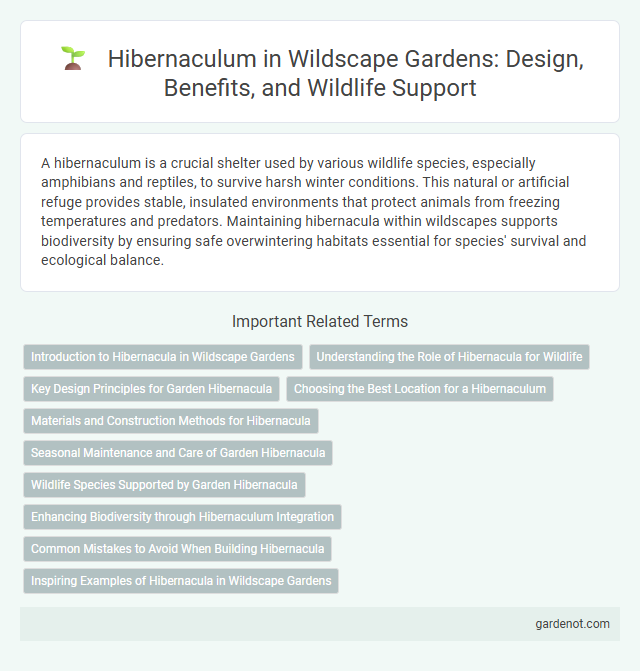A hibernaculum is a crucial shelter used by various wildlife species, especially amphibians and reptiles, to survive harsh winter conditions. This natural or artificial refuge provides stable, insulated environments that protect animals from freezing temperatures and predators. Maintaining hibernacula within wildscapes supports biodiversity by ensuring safe overwintering habitats essential for species' survival and ecological balance.
Introduction to Hibernacula in Wildscape Gardens
Hibernacula in Wildscape Gardens provide essential shelter for hibernating wildlife, creating a safe and insulated environment that supports biodiversity throughout the winter months. These specially designed structures mimic natural habitats, promoting successful hibernation for amphibians, reptiles, and insects by maintaining stable temperatures and humidity. Integrating hibernacula into the Wildscape enhances ecological balance and encourages the conservation of vulnerable species.
Understanding the Role of Hibernacula for Wildlife
Hibernacula serve as critical shelters where various wildlife species, including bats, amphibians, and reptiles, safely undergo hibernation during colder months. These natural or artificial structures provide stable microclimates that protect animals from harsh environmental conditions and predators. Understanding the role of hibernacula aids in conservation efforts by highlighting the importance of preserving these habitats to maintain biodiversity and ecological balance.
Key Design Principles for Garden Hibernacula
Garden hibernacula are designed to provide safe, insulated shelters for overwintering wildlife such as amphibians, reptiles, and insects by mimicking natural habitats with materials like logs, stones, and leaf litter. Key design principles include ensuring moisture retention to prevent desiccation, creating varied microhabitats with different depths and textures for species-specific needs, and positioning the structure in a sheltered, undisturbed location to maintain stable temperatures. Proper drainage and ventilation are essential to avoid waterlogging while preserving humidity, supporting biodiversity and enhancing the garden's ecological value.
Choosing the Best Location for a Hibernaculum
Selecting the optimal location for a hibernaculum involves identifying sites with stable temperatures between 2degC and 10degC and high humidity levels to prevent desiccation of hibernating species. Ideal hibernacula are often found in natural features such as caves, rock crevices, or underground burrows that provide protection from predators and minimal disturbance. Proximity to foraging habitats and the presence of suitable soil substrates also enhance the survival chances of amphibians and reptiles during their dormant periods.
Materials and Construction Methods for Hibernacula
Hibernacula are constructed using natural materials such as logs, rocks, soil, and leaf litter to create insulated, moisture-retentive environments that mimic natural winter habitats. Construction methods emphasize layering and compacting substrates to maintain stable temperatures and humidity levels critical for wildlife overwintering, particularly amphibians and reptiles. Strategic placement in shaded, protected areas ensures minimal disturbance and optimal microclimate conditions essential for successful hibernation.
Seasonal Maintenance and Care of Garden Hibernacula
Seasonal maintenance of garden hibernacula involves regular inspection to ensure the structure remains insulated and dry, protecting amphibians and reptiles during winter. Clearing debris and checking for water ingress preserves optimal conditions for species survival throughout hibernation. Timely planting of native vegetation around the hibernaculum enhances microhabitats, promoting biodiversity and ecological balance.
Wildlife Species Supported by Garden Hibernacula
Garden hibernacula provide essential shelter and overwintering habitats for diverse wildlife species, including amphibians such as frogs and newts, reptiles like slow worms and grass snakes, and invertebrates such as hedgehogs and beetles. These structures maintain stable microclimates that protect vulnerable species from harsh weather, enhancing local biodiversity and ecosystem resilience. Supporting natural hibernation cycles contributes to the conservation of declining species by offering safe refuges within garden environments.
Enhancing Biodiversity through Hibernaculum Integration
Hibernaculum integration in Wildscape projects significantly enhances biodiversity by providing essential overwintering habitats for amphibians, reptiles, and invertebrates. These carefully constructed shelters ensure species survival during harsh conditions, supporting population stability and ecological balance. Incorporating hibernacula promotes habitat connectivity and fosters resilient ecosystems within native landscapes.
Common Mistakes to Avoid When Building Hibernacula
When building a hibernaculum, avoid using non-native materials that can alter soil composition and harm sheltering species. Ensure proper drainage to prevent moisture buildup, which can lead to fungal growth and negatively impact hibernating animals. Position the structure away from direct sunlight and strong winds to maintain a stable, cool environment essential for effective hibernation.
Inspiring Examples of Hibernacula in Wildscape Gardens
Hibernacula in Wildscape gardens serve as essential overwintering shelters, providing amphibians, reptiles, and insects with safe, insulated environments critical for survival during cold months. Inspired by natural designs, these structures often incorporate layered logs, soil mounds, and dense vegetation, mimicking native habitats to promote biodiversity and ecological balance. Examples such as the layered stone hibernaculum at the Wildscape Reserve enable species like common toads and slow worms to thrive through winter, demonstrating effective conservation strategies.
Hibernaculum Infographic

 gardenot.com
gardenot.com